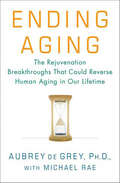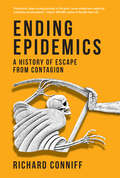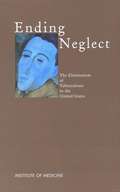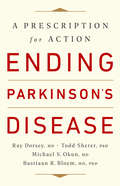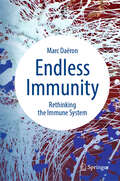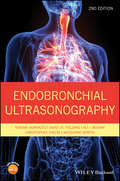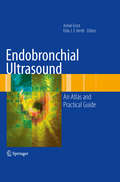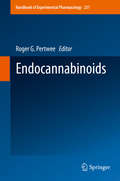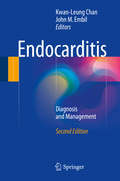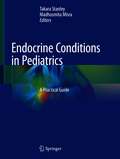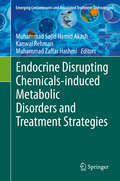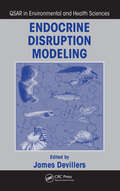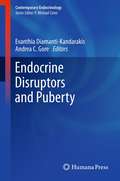- Table View
- List View
Ending Addiction for Good: The Groundbreaking, Holistic, Evidence-Based Way to Transform Your Life
by Richard Taite Constance ScharffThere is hardly a family in the post-industrial world that hasn't been affected in some way by addiction. Yet seeking treatment for a struggling loved one is, for most people, a frightening and overwhelming prospect. Ending Addiction for Good offers a powerful message of hope. Drawing on their own histories of addiction recovery, authors Taite and Scharff examine the unique and highly successful treatment protocol practiced at the Cliffside Malibu Addiction Treatment Center. Using clear and direct language, they look beyond the limits of conventional treatment to show how creating an individualized, evidence-based, and integrated approach that targets the whole person - mind, body, and spirit - not just the addiction, can provide a sure path to recovery. In doing so, they empower both the addict and the families of addicts to begin their recovery. Ending Addiction for Good may well be the most important book dealing with alcoholism and drug addiction to come along in years.
Ending Aging: The Rejuvenation Breakthroughs That Could Reverse Human Aging in Our Lifetime
by Aubrey de Grey Michael RaeMUST WE AGE? A long life in a healthy, vigorous, youthful body has always been one of humanity's greatest dreams. Recent progress in genetic manipulations and calorie-restricted diets in laboratory animals hold forth the promise that someday science will enable us to exert total control over our own biological aging. Nearly all scientists who study the biology of aging agree that we will someday be able to substantially slow down the aging process, extending our productive, youthful lives. Dr. Aubrey de Grey is perhaps the most bullish of all such researchers. As has been reported in media outlets ranging from 60 Minutes to The New York Times, Dr. de Grey believes that the key biomedical technology required to eliminate aging-derived debilitation and death entirely—technology that would not only slow but periodically reverse age-related physiological decay, leaving us biologically young into an indefinite future—is now within reach.In Ending Aging, Dr. de Grey and his research assistant Michael Rae describe the details of this biotechnology. They explain that the aging of the human body, just like the aging of man-made machines, results from an accumulation of various types of damage. As with man-made machines, this damage can periodically be repaired, leading to indefinite extension of the machine's fully functional lifetime, just as is routinely done with classic cars. We already know what types of damage accumulate in the human body, and we are moving rapidly toward the comprehensive development of technologies to remove that damage. By demystifying aging and its postponement for the nonspecialist reader, de Grey and Rae systematically dismantle the fatalist presumption that aging will forever defeat the efforts of medical science.
Ending Child Abuse: New Efforts in Prevention, Investigation, and Training
by Victor I. Vieth Bette L. Bottoms Alison PeronaGet the tools to coordinate a plan in your community!The highly anticipated Ending Child Abuse: New Efforts in Prevention, Investigation, and Training presents an exciting vision: to end or significantly reduce child abuse. Respected social scientists and legal scholars discuss empirically sound short- and long- term multidisciplinary strategies that can be implemented in our society. Innovative and well-established concepts and approaches are clearly presented, such as specialized education, rational preventative methods, effective investigation and prosecution strategies, and the analysis of factors that influence law enforcement investigations and child abuse prevention efforts.Several obstacles stand in the way of the elimination of child abuse, such as the failure to investigate most child abuse reports, inadequate training of frontline child protection professionals, lack of financial resources, and the dilemma that child abuse is not addressed at the youngest ages. Ending Child Abuse: New Efforts in Prevention, Investigation, and Training tackles these problems and others with practical guidelines and aggressive creative strategies that can be applied to every community in the United States. This collection is impeccably referenced and soundly supported with research.Ending Child Abuse: New Efforts in Prevention, Investigation, and Training discusses: implementation of a model curriculum in child advocacy for undergraduate and graduate institutions forensic interview training extensive education of the nation&’s child protection professionals development and funding of prevention programs at the community level educational reforms of Montclair State University in New Jersey designed to better prepare professionals who advocate for children research-based interview techniques with best practice guidelines possible broader social and system-level reforms vertical prosecution of child abuse cases-with a model for its operationEnding Child Abuse: New Efforts in Prevention, Investigation, and Training is an ambitious eye-opening source perfect for social services professionals, mental health professionals, practitioners, researchers, educators, students, and medical and legal professionals who deal with child abuse and children&’s welfare.
Ending Epidemics: A History of Escape from Contagion
by Richard ConniffHow scientists saved humanity from the deadliest infectious diseases—and what we can do to prepare ourselves for future epidemics.After the unprecedented events of the COVID-19 pandemic, it may be hard to imagine a time not so long ago when deadly diseases were a routine part of life. It is harder still to fathom that the best medical thinking at that time blamed these diseases on noxious miasmas, bodily humors, and divine dyspepsia. This all began to change on a day in April 1676, when a little-known Dutch merchant described bacteria for the first time. Beginning on that day in Delft and ending on the day in 1978 when the smallpox virus claimed its last known victim, Ending Epidemics explains how we came to understand and prevent many of our worst infectious diseases—and double average life expectancy. Ending Epidemics tells the story behind &“the mortality revolution,&” the dramatic transformation not just in our longevity, but in the character of childhood, family life, and human society. Richard Conniff recounts the moments of inspiration and innovation, decades of dogged persistence, and, of course, periods of terrible suffering that stir individuals, institutions, and governments to act in the name of public health. Stars of medical science feature in this drama, but lesser-known figures also play a critical role. And while the history of germ theory is central to this story, Ending Epidemics also describes the importance of everything from sanitation improvements and the discovery of antibiotics to the development of the microscope and the syringe—technologies we now take for granted.
Ending Medical Reversal: Improving Outcomes, Saving Lives
by Vinayak K. Prasad Adam S. CifuWhy medicine adopts ineffective or harmful medical practices only to abandon them—sometimes too late.Medications such as Vioxx and procedures such as vertebroplasty for back pain are among the medical "advances" that turned out to be dangerous or useless. What Dr. Vinayak K. Prasad and Dr. Adam S. Cifu call medical reversal happens when doctors start using a medication, procedure, or diagnostic tool without a robust evidence base—and then stop using it when it is found not to help, or even to harm, patients.In Ending Medical Reversal, Drs. Prasad and Cifu narrate fascinating stories from every corner of medicine to explore why medical reversals occur, how they are harmful, and what can be done to avoid them. They explore the difference between medical innovations that improve care and those that only appear to be promising. They also outline a comprehensive plan to reform medical education, research funding and protocols, and the process for approving new drugs that will ensure that more of what gets done in doctors' offices and hospitals is truly effective.
Ending Neglect: The Elimination of Tuberculosis in the United States
by Institute of MedicineTuberculosis emerged as an epidemic in the 1600s, began to decline as sanitation improved in the 19th century, and retreated further when effective therapy was developed in the 1950s. TB was virtually forgotten until a recent resurgence in the U.S. and around the world-ominously, in forms resistant to commonly used medicines.What must the nation do to eliminate TB? The distinguished committee from the Institute of Medicine offers recommendations in the key areas of epidemiology and prevention, diagnosis and treatment, funding and organization of public initiatives, and the U.S. role worldwide. The panel also focuses on how to mobilize policy makers and the public to effective action.The book provides important background on the pathology of tuberculosis, its history and status in the U.S., and the public and private response.The committee explains how the U.S. can act with both self-interest and humanitarianism in addressing the worldwide incidence of TB.
Ending Parkinson's Disease: A Prescription for Action
by Michael S. Okun Ray Dorsey Todd Sherer Bastiaan R. BloemIn this "must-read" guide (Lonnie Ali), four leading doctors and advocates offer a bold action plan to prevent, care for, and treat Parkinson's disease—one of the great health challenges of our time Brain diseases are now the world's leading source of disability. The fastest growing of these is Parkinson's: the number of impacted patients has doubled to more than six million over the last twenty-five years and is projected to double again by 2040. Harmful pesticides that increase the risk of Parkinson's continue to proliferate, many people remain undiagnosed and untreated, research funding has stagnated, and the most effective treatment is now a half century old. In Ending Parkinson's Disease, four top experts provide a plan to help prevent Parkinson's, improve care and treatment, and end the silence associated with this devastating disease. This is an indispensable guide for patients, families, clinicians, scientists, politicians, and activists.
Ending the Social Care Crisis: A New Road to Reform
by Richard HumphriesWhat lies behind England’s crisis in adult social care, why has real change been so hard and what can be done? Ensuring effective, sustainable and affordable care and support for people of all ages is an urgent public policy challenge. This vital book outlines a different vision of social care as an essential part of the country’s economic and social infrastructure that enables people to live good lives. Drawing on the history of social care, international comparisons and lived experience, it sets out a different road to reform that will secure political traction and public support for change.
Endless Immunity: Rethinking the Immune System
by Marc DaëronThis book takes the reader on an inspiring journey into the immune system, challenging long-held beliefs about immunity. It examines the immune system under historical, philosophical and biological perspectives. It proposes a new way of understanding immunity that goes beyond the binary opposition between self and non-self. Indeed, we, the livings, are chimeras. Mammals, birds, reptiles or fish, insects, spiders or mollusks, plants or algae, we are all made up of a community of living beings who share their lives in the same 'meta-organism'. If we live together, it is because we need each other to live, and if we can live together, it is because an immune system makes it possible, by adapting us to them and by adapting them to us. From this mutual adaptation a new kind of immunity emerges, dynamic, relational, never acquired, an endless immunity. Immunity that this system makes possible is not perfect, far from it, it is a compromise which does not always prevent disease; sometimes it even causes it. Disease is the cost of immunity. Because what the immune system enables is much more essential than the defense of the organism, it is the very existence of the meta-organism that we are. Immunity is more than a protection; it is a condition of existence. With its didactic structure and accessible style, this book is an essential resource for anyone interested in understanding the nature and function of the immune system. It also offers different levels of complexity from which the reader can choose, depending on his or her background, without compromising the main message of the text. With a Foreword from Alfred I. Tauber
Endlich Biochemie verstehen
by Jonathan Wolf MuellerDieses Buch beantwortet brennende Fragen nach dem (molekularen) Sinn des Lebens und macht Lust auf mehr. Was ist es denn „was die Welt, im Innersten zusammenhält“. Das Buch ist als Lehrbuch konzipiert und macht übergeordnete Konzepte der Biochemie mit einfachen Bildern begreifbar. Die Konzepte oder spannenden Fragen der Kapitel werden mit viel Witz und über einfache Eselsbrücken den Studierenden näher gebracht.
Endlich schwanger: Ein Ratgeber für Paare mit Kinderwunsch
by Sebastian FindekleeWünschen Sie sich als Paar schon länger ein Kind und es „klappt einfach nicht“?Dieser Ratgeber gibt Ihnen als Frau und Mann Mut, den Wunsch nach einer Schwangerschaft erfüllen zu können. Der erfahrene Arzt und Reproduktionsmediziner gibt Ihnen hilfreiche Tipps aus der Praxis und stellt moderne Behandlungsverfahren vor. Verständlich geschrieben und wissenschaftlich fundiert erfahren Sie mehr über Ursachen, Diagnostik bei Kinderlosigkeit und bewährte Therapieverfahren und Methoden, u.a. ERA Trio-Test oder Polkörperdiagnostik. Auch auf weniger bekannte Methoden wird eingegangen. Dabei erfahren Sie auch, welchen Einfluss biologische wie seelische Komponenten auf eine Schwangerschaft haben können.Geschrieben für alle Paare mit dem Wunsch nach einem eigenen Kind, aber auch für interessierte Angehörige sowie alle Gynäkologinnen und Gynäkologen lesenswert.
Endobronchial Ultrasonography
by Noriaki Kurimoto Ali I. Musani Katsuhiko Morita David I. Fielding Christopher KnieseEndobronchial ultrasonography (EBUS) is an exciting and still developing diagnostic tool that has added significantly to the diagnosis and staging of lung cancer and other thoracic diseases. Co-authored by one of the technology's pioneers, this book helps the reader to use EBUS to diagnose and stage lung cancer and a variety of different tumours of the chest region. The second edition of Endobronchial Ultrasonography covers all of the standard techniques and the very latest developments and guidelines involved in EBUS, combining two common procedures, bronchoscopy and real-timeultrasonography, allowing physicians to obtain precise biopsies of lymph nodes and masses within the chest cavity.
Endobronchial Ultrasonography
by Noriaki Kurimoto David I. K. Fielding Ali I. MusaniEndobronchial ultrasonography (EBUS) is an exciting new diagnostic tool that has added significantly to the diagnosis and staging of lung cancer and other thoracic diseases. This book is co-authored by one of the technology's pioneers and will help the reader to use EBUS to diagnose and stage lung cancer and a variety of different tumours of the chest region. Endobronchial Ultrasonography covers all of the standard techniques and the new developments involved in EBUS as it combines two common procedures, bronchoscopy and real-time ultrasonography. This allows physicians to obtain precise biopsies of lymph nodes and masses within the chest cavity. Over 250 high quality colour digital images are featured throughout the book to illustrate the different applications of EBUS, complemented by specific case studies. This book is accompanied by a companion website featuring over 30 video clips cited in the text.
Endobronchial Ultrasound
by Felix Jf Herth Armin ErnstEndobronchial ultrasound has received explosive attention amongst pulmonologists, thoracic surgeons and gastroenterologists and the procedure is increasingly being performed. Even though the technology has been in use for over 10 years, technical modifications have just recently lead to the ability for near ubiquitous use. The editors and contributors have all been active in the field for years, are well published and certainly are considered opinion leaders and well-traveled teachers, having offered many courses in bronchoscopy and endobronchial ultrasound.
Endobronchial Ultrasound Made Easy
by Kazuhiro Yasufuku Rajesh ThomasThis is a concise, yet comprehensive book that teaches all essential aspects of the practice of Endobronchial Ultrasound (EBUS) bronchoscopy. Written by world experts, who share their clinical experience to provide a practical and step-by-step approach to learning and performing linear and radial EBUS bronchoscopy. Supplemented by more than 250+ high-quality illustrations, images and videos selected from the authors’ personal collections, all chapters include expert tips, clinical pearls, rare cases and interactive self-assessment sections to enhance and reinforce the learning of both beginner and advanced bronchoscopists wishing to learn, practice and teach EBUS.Key Features: Features rare and interesting EBUS cases followed by Multiple Choice Questions in each chapter Explores the subject through a wealth of accompanying illustrations and teaching videos for a fun learning experience for bronchoscopists, fellows and trainees in respiratory medicine, oncologists and thoracic surgeons who perform EBUS Fills a spot in the market for a quick reference which has updated, practical information from international experts in the field of EBUS with a strong visual component which is especially key for this diagnostic modality.
Endocannabinoid Regulation of Monoamines in Psychiatric and Neurological Disorders
by Elisabeth J. Van BockstaeleThe past decade has seen tremendous growth in the study of cannabinoid receptor signaling in brain. The impact and consequences of cannabinoid modulation of monoaminergic (dopamine, norepinephrine, and serotonin) circuits is becoming more clear. Scientists have shown significant interaction between these two systems in a variety of psychiatric and neurological disorders such as affective disorders, multiple sclerosis, and pain or pain disorders. The overarching goal of Endocannabinoid Regulation of Monoamines in Psychiatric and Neurological Disorders is to provide current information on advances in the field of endocannabinoid signaling and potential therapeutic applications with a particular emphasis on monoaminergic circuits.
Endocannabinoid Signaling: Methods and Protocols (Methods in Molecular Biology #2576)
by Mauro MaccarroneThis second edition provides new and updated chapters detailing all major elements of the ECB system. Chapters guide readers through identification of drug targets, electrophysiology, computational chemistry, and machine learning. Written in the successful Methods in Molecular Biology series format, chapters include introductions to their respective topics, lists of the necessary materials and reagents, step-by-step, readily reproducible protocols, and notes on troubleshooting and avoiding known pitfalls. Comprehensive and cutting-edge, Endocannabinoid Signaling: Methods and Protocols, Second Edition is a valuable resource for all researchers interested in learning more about this important and developing field.
Endocannabinoids
by Roger G. PertweeThere is currently considerable interest in the development of medicines that would enhance endocannabinoid-induced "autoprotection", for example through inhibition of endocannabinoid metabolizing enzymes or cellular uptake processes or that would oppose endocannabinoid-induced "autoimpairment". This volume describes the physiology, pathophysiology and pharmacology of the endocannabinoid system and potential strategies for targeting this system in the clinic.
Endocarditis
by Kwan-Leung Chan John M. EmbilThis new addition will provide an update on the current prophylaxis guidelines, the new diagnostic approach in the detection of the disease, the proposed schemas to predict prognosis, and the new treatment strategies to improve the outcome of patients afflicted with this serious condition. Endocarditis is a serious disease with ahigh rate of morbidity and mortality. The in-hospital mortality remains at 10-20%. The poor outcome ofpatients with this condition is due in large part to the delay in making thediagnosis which frequently can be elusive. As a result of its wide spectrum of manifestations, endocarditis canmimic many different conditions ranging from stroke to renal failure. In order to minimize the delay in diagnosis,clinicians need to always be mindful of the possibility that endocarditis maybe the cause of the symptoms. There have been ongoing efforts in thedevelopment of molecular probes and new imaging techniques to improve ourability to identify the disease early and reliably. New treatment strategies have been studiedwith the aim to prevent complications and to improve survival. Thestructure of the previous edition is preserved. The book is divided into three sections with the first section coveringthe historical perspective and basic principles, the second section dealingwith the diagnosis and management approaches and the last section on specificclinical situations that pose management dilemmas. All the chapters will be updated to include newinformation from the recent studies. Inparticular, the approach to the use of antibiotic prophylaxis will beextensively revised to present and discuss the implications of the currentguidelines from different national societies including the American HeartAssociation and the British Society for Antimicrobial Chemotherapy. This update is timely and should be ofinterest to all clinicians involved in the care of patients with this seriousdisease. This new edition will be a good resource forinternists, infectious disease specialists, cardiologists and cardiac surgeonsalike .
Endocrine Conditions in Pediatrics: A Practical Guide
by Madhusmita Misra Takara StanleyThis book is aimed at primary care providers who care for the pediatric age group (general pediatrician, the PCP working with pediatric patients, and family medicine providers) with the goal of covering the endocrine differential diagnosis of common signs and symptoms of possible endocrine disease as well as appropriate initial laboratory evaluation and interpretation. While multiple pediatric endocrine textbooks exist, most of them are heavy in coverage of physiology and rare diseases, with less discussion of practical steps in evaluation and diagnosis. This book distinguishes itself through a very practical approach. The first section is organized by presenting signs and symptoms, the second section is organized by laboratory interpretation, and the third section provides summaries of common pediatric endocrine disorders. Chapters are concise, providing critical clinical information including clinical pearls, common diagnoses and important points in patient counseling. Written by experts in the field, Endocrine Conditions in Pediatrics is a valuable resource that provides general pediatricians and other primary care providers with all of the information they need to provide superb patient care before transferring to a pediatric endocrinologist when necessary.
Endocrine Diseases in Pregnancy and the Postpartum Period
by Nadia BarghouthiThis book delivers comprehensive explanations of normal hormonal physiology during pregnancy and descriptions of the hormonal pathology associated with various endocrine disease states. In addition, it serves as a relevant and synoptic resource for the clinical management of endocrine disorders in pregnancy and the prepartum and postpartum periods. Evaluation and management of endocrine disorders including, but not limited to, diabetes mellitus, thyroid disease, and various endocrine tumors are discussed. It provides readers with a detailed overview in a compact and easy-to-read format. This book serves as essential reading for Endocrinology fellows and Obstetrics and Gynecology residents. KEY FEATURES Explains normal physiology of pregnancy in addition to the physiology, evaluation, and management of endocrine diseases in pregnancy and in the prepartum and postpartum periods Explores from a clinical standpoint with practical applications; useful for students, residents, fellows, mid-level providers, and practicing physicians Discusses special considerations and emerging topics including pregnancy in transgender men, obesity and metabolism, and endocrine emergencies
Endocrine Disorders in Kidney Disease: Diagnosis and Treatment
by Gregory A. Brent Kamyar Kalantar-Zadeh Connie M. RheeThis comprehensive book examines the complex interplay between endocrine and kidney disorders, and how this inter-relationship impacts patients with chronic kidney disease. Authored by experts in areas of endocrinology and nephrology, chapters cover a variety of topics, including diabetes, metabolic syndrome, thyroid dysfunction, gonadal disorders, dyslipidemia, mineral bone disorders, obesity, and pituitary disorders. These comorbidities are thoroughly examined and provide the clinician, researcher, and trainee with a greater understanding of the impact of endocrine disorders on kidney disease patients, the ability to identify persistent gaps in knowledge for future investigation, and move closer towards the goal of improving the health and survival of the chronic kidney disease population.
Endocrine Disrupting Chemicals-induced Metabolic Disorders and Treatment Strategies (Emerging Contaminants and Associated Treatment Technologies)
by Muhammad Zaffar Hashmi Muhammad Sajid Hamid Akash Kanwal RehmanThis volume offers a detailed and comprehensive analysis of Endocrine Disrupting Chemicals (EDCs), covering their occurrence, exposure to humans and the mechanisms that lead to the parthogenesis of EDCs-induced metabolic disorders. The book is divided into three parts. Part I describes the physiology of the human endocrine system, with special emphasis on various types of metabolic disorders along with risk factors that are responsible for the development of these disorders. Part II addresses all aspects of EDCs, including their role in the induction of various risk factors that are responsible for the development of metabolic disorders. Part III covers up-to-date environmental regulatory considerations and treatment strategies that have been adopted to cure and prevent EDCs-induced metabolic disorders. This section will primarily appeal to clinicians investigating the causes and treatment of metabolic disorders. The text will also be of interest to students and researchers in the fields of Environmental Pharmacology and Toxicology, Environmental Pollution, Pharmaceutical Biochemistry, Biotechnology, and Drug Metabolism/Pharmacokinetics.
Endocrine Disruption Modeling (QSAR in Environmental and Health Sciences)
by James DevillersUses Computational Tools to Simulate Endocrine Disruption PhenomenaEndocrine Disruption Modeling provides a practical overview of the current approaches for modeling endocrine activity and the related potential adverse effects they may induce on environmental and human health. Based on the extensive research of an international panel of contributor
Endocrine Disruptors and Puberty
by Evanthia Diamanti-Kandarakis Andrea C. GoreEndocrine disruption represents one of the most controversial environmental issues of our time. Mounting evidence stemming from more than 10 years of experimental, epidemiological and clinical studies has transformed the once generally discounted subject of endocrine disruptors into an issue of tremendous concern not only within the scientific community but among society as a whole. Following initial evidence from basic research, endocrine disruption in humans has now emerged as a major medical challenge. In this respect, puberty, a crucial developmental stage, has been definitively identified as a key window of vulnerability with regard to endocrine disruptors. Written by leading authorities in the field, Endocrine Disruptors and Puberty offers an engaging and comprehensive overview of this fascinating and rapidly growing problem. An indispensable resource for all clinicians and scientists interested in this challenging endocrinologic topic, Endocrine Disruptors and Puberty is a timely contribution that will help navigate a path toward understanding the problem and developing solutions.

